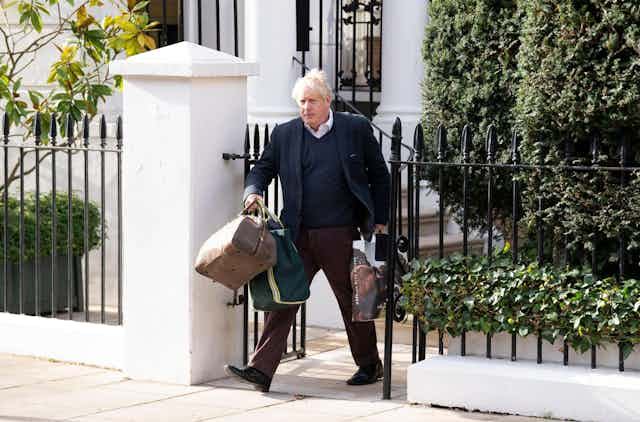The UK is facing three byelections in constituencies all vacated within 24 hours of one another. Former prime minister Boris Johnson announced he was leaving parliament with immediate effect on June 9, leaving his Uxbridge and South Ruislip constituents in need of a new MP. His vocal supporter Nadine Dorries had resigned as an MP just hours before in what appears to be a linked case, triggering a byelection in Mid Bedfordshire. And the day after Johnson’s departure, another MP quit. This time, it was former Cabinet Office minister Nigel Adams. A byelection will go ahead in his Selby and Ainsty constituency in North Yorkshire.
So what can we expect in these three byelections to be held in the weeks ahead (and perhaps even in a fourth if the people of Rutherglen and Hamilton West decide to recall Scottish National Party MP Margaret Ferrier over her lockdown rule-breaking)?
First, pay attention to who is popping up in these constituencies. If any one of prime minister Rishi Sunak, Labour leader Keir Starmer or Liberal Democrat leader Ed Davey fail to make an appearance doorstepping, handing out leaflets or speaking to activists, that indicates their party has little hope.
Alternatively, if a seat is deluged by one particular party leader, accompanied by their senior party figures and the occasional celebrity supporter, they might have scented victory.
The parties have been quick off the mark – Davey has already been out leafleting in Mid Bedfordshire, Labour has already selected its candidate in Uxbridge and South Ruislip and the Conservatives likewise in Selby and Ainsty. Emails asking for support for the byelection campaigns are already landing in member inboxes.
Despite all of the attention byelections cause, we don’t know as much about them as we would like. I’ve taken a look at 148 byelections since 1979 – here are some important things to watch out for:
On average, there have been eight byelections per parliament between 2010 and 2019 – however, excluding these latest events, the 2019 parliament has already seen 13. The figures are pretty comparable though to earlier parliaments – there were 18 between 1992 and 1997.
But there has been a big shift in another way. While byelections most often used to happen because the sitting MP had died, in contemporary British politics MPs are triggering byelections by resigning (the cause of nine of the 13 so far in this parliament).
Roughly two-thirds of seats where byelections were held between 1979 and 2022 were occupied by the same party before and after. It is also worth pointing out that if a seat changes hands at a byelection, it doesn’t mean it will stay with the new incumbent at the subsequent general election.
Johnson’s return: an unlikely scenario
It was once the case that byelections represented useful routes back into parliament for former MPs who may have voluntarily or involuntarily stepped back from politics. After Johnson’s resignation last week, in which he said he was stepping back from politics “for now”, it was mooted that he may seek to re-enter parliament in this way, even via Dorries’s seat.
However, patterns from contemporary byelections don’t appear to be particularly favourable if this is indeed the plan. Former Conservative minister Michael Portillo was the last former MP to successfully re-enter parliament via a byelection in 1999. Since then, only two former MPs have been selected to fight byelections, and neither of them have been successful.
In terms of former prime ministers using byelections to re-enter parliament, we have to go ever further back to Arthur James Balfour in 1906 and he didn’t appear to have burned quite as many bridges with the leadership as Johnson has.
Even were the latter obstacle to be overcome, parachuting Johnson into a seat with which he has little connection could be controversial in itself, since most Conservative byelection candidates have ties to the local area.
Instead of admitting former MPs into parliament, byelections instead appear to act more usefully as an arena in which inexperienced candidates can gain campaigning experience. Of recent prime ministers, Liz Truss, Tony Blair and Theresa May all fought and lost byelections before being successfully elected to parliament.
Bad news for the incumbents
Whatever else happens in Mid Bedfordshire, Uxbridge and South Ruislip and Selby and Ainsty, turnouts in the byelections will be below what the seats saw in 2019. The last time turnout increased at a byelection was way back in 1987.

In the upcoming byelections, the Conservatives are most likely to see their vote fall. Recent byelections have shown us that the Conservative byelection vote share is significantly affected by two dimensions: the level of the party’s previous support in the seat, and their position in national polls. With all three upcoming byelections happening in Conservative seats, although the party’s incumbency may insulate them a little, the national opinion polling makes it a potentially uncomfortable night for the Conservatives.

